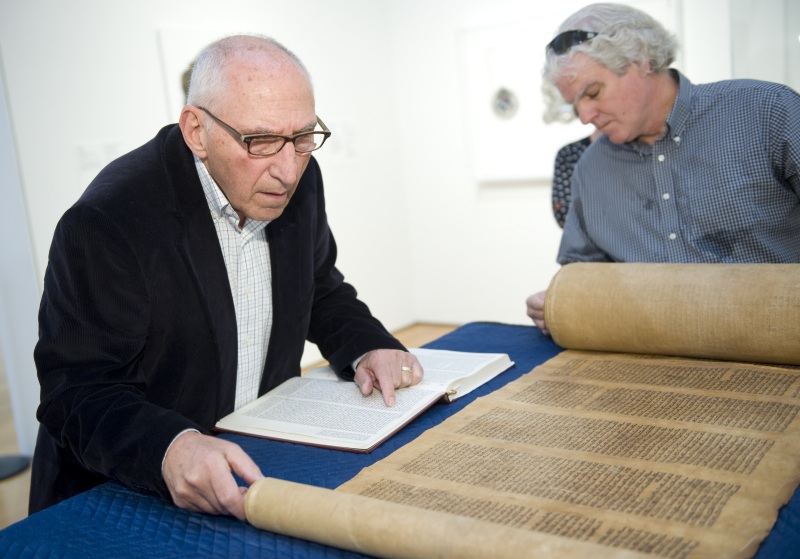Museum shares Torah details

Saul Schiffman helps to find a passage in the Torah. He is assisted by a museum staff member.
The Torah, like the Morroccan one at the North Carolina Museum of Art, contains the five books of Moses; Genesis, Exodus, Leviticus, Numbers and Deuteronomy, written on parchment made from the skins of a kosher animal, such as a deer, goat, cow etc.,” Saul Schiffman, a friend of the Judaic Art Gallery at the North Carolina Museum of Art said. “The skin is soaked, stretched and scraped to create a smooth light colored writing surface. Over the centuries a scroll can darken to a brown color as has this one here and most of the fragments from the Dead Sea Scrolls.”
Schiffman recently shared information about how a Torah is prepared, written and maintained.
He explained that a scribe (sofer) copies the scroll onto the parchment word for word being careful not to make any mistakes. If a mistake is made it must be corrected, otherwise the scroll is not ritually pure. He added that the scribe spends years in training to be qualified to write sacred texts. It takes about a year to write one Torah scroll, including the work of the scribes and checking the text by other scribes. Texts written by scribes do not simply include the Torah, but also a mezuzah (affixed to the doorposts of Jewish homes), phylacteries (tefillin) worn during weekday morning prayers and megillot (such as the Book of Esther).
“In the Museum’s Judaic Art Gallery, we roll the Torah scroll to a different section about twice every year. The portion chosen either coincides with a ritual performed by Jews during the same time of the year or a text of general interest. For 2013, during the first half of the year, the scroll was turned to the priestly benediction (Numbers 6:23-27) recited by the Rabbi and/or cohanim (descendants of Aaron) during Jewish religious services. This same blessing is also recited at most Christian church services around the world,” he shared. This particular scroll was made of soft deerskin and is fragile. It has to be handled with care. The museum’s staff have to wear gloves when handling this artifact.
During the remainder of 2013-14, the scroll was turned to the portion recanting the death and burial of Abraham. Schiffman said that the significance of this short portion was that “even though Isaac and Ishmael may not have been close to each other, they came together to bury their father showing reverence and respect (Genesis 25: 1-10).”
The Torah, housed in a silver Sephardic case, is on display at the North Carolina Museum of Art’s Judaic Art Gallery.
For more information, visit ncartmuseum.org.
